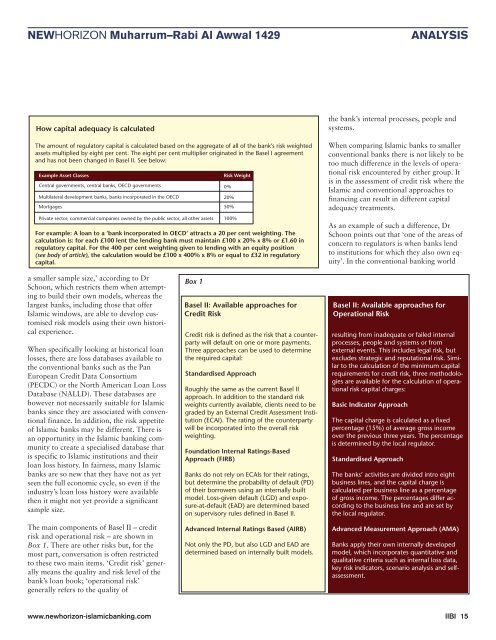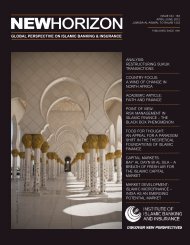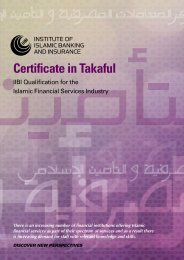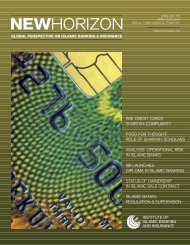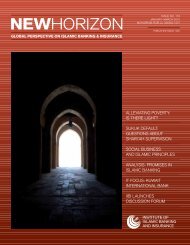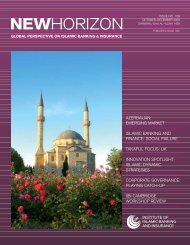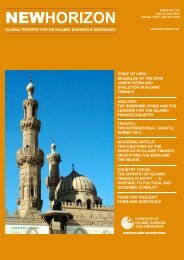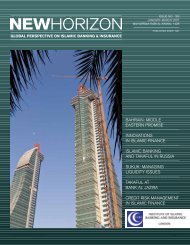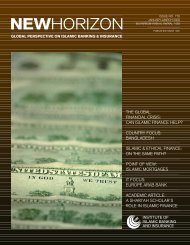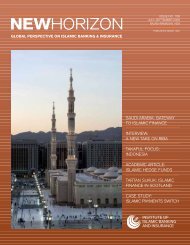BANK KESHAVARZI IRAN
issue no. 167 - Institute of Islamic Banking and Insurance
issue no. 167 - Institute of Islamic Banking and Insurance
- No tags were found...
You also want an ePaper? Increase the reach of your titles
YUMPU automatically turns print PDFs into web optimized ePapers that Google loves.
NEWHORIZON Muharrum–Rabi Al Awwal 1429<br />
ANALYSIS<br />
How capital adequacy is calculated<br />
The amount of regulatory capital is calculated based on the aggregate of all of the bank’s risk weighted<br />
assets multiplied by eight per cent. The eight per cent multiplier originated in the Basel I agreement<br />
and has not been changed in Basel II. See below:<br />
Example Asset Classes<br />
Central governments, central banks, OECD governments 0%<br />
Multilateral development banks, banks incorporated in the OECD 20%<br />
Mortgages 50%<br />
Private sector, commercial companies owned by the public sector, all other assets 100%<br />
Risk Weight<br />
For example: A loan to a ‘bank incorporated in OECD’ attracts a 20 per cent weighting. The<br />
calculation is: for each £100 lent the lending bank must maintain £100 x 20% x 8% or £1.60 in<br />
regulatory capital. For the 400 per cent weighting given to lending with an equity position<br />
(see body of article), the calculation would be £100 x 400% x 8% or equal to £32 in regulatory<br />
capital.<br />
the bank’s internal processes, people and<br />
systems.<br />
When comparing Islamic banks to smaller<br />
conventional banks there is not likely to be<br />
too much difference in the levels of operational<br />
risk encountered by either group. It<br />
is in the assessment of credit risk where the<br />
Islamic and conventional approaches to<br />
financing can result in different capital<br />
adequacy treatments.<br />
As an example of such a difference, Dr<br />
Schoon points out that ‘one of the areas of<br />
concern to regulators is when banks lend<br />
to institutions for which they also own equity’.<br />
In the conventional banking world<br />
a smaller sample size,’ according to Dr<br />
Schoon, which restricts them when attempting<br />
to build their own models, whereas the<br />
largest banks, including those that offer<br />
Islamic windows, are able to develop customised<br />
risk models using their own historical<br />
experience.<br />
When specifically looking at historical loan<br />
losses, there are loss databases available to<br />
the conventional banks such as the Pan<br />
European Credit Data Consortium<br />
(PECDC) or the North American Loan Loss<br />
Database (NALLD). These databases are<br />
however not necessarily suitable for Islamic<br />
banks since they are associated with conventional<br />
finance. In addition, the risk appetite<br />
of Islamic banks may be different. There is<br />
an opportunity in the Islamic banking community<br />
to create a specialised database that<br />
is specific to Islamic institutions and their<br />
loan loss history. In fairness, many Islamic<br />
banks are so new that they have not as yet<br />
seen the full economic cycle, so even if the<br />
industry’s loan loss history were available<br />
then it might not yet provide a significant<br />
sample size.<br />
The main components of Basel II – credit<br />
risk and operational risk – are shown in<br />
Box 1. There are other risks but, for the<br />
most part, conversation is often restricted<br />
to these two main items. ‘Credit risk’ generally<br />
means the quality and risk level of the<br />
bank’s loan book; ‘operational risk’<br />
generally refers to the quality of<br />
Box 1<br />
Basel II: Available approaches for<br />
Credit Risk<br />
Credit risk is defined as the risk that a counterparty<br />
will default on one or more payments.<br />
Three approaches can be used to determine<br />
the required capital:<br />
Standardised Approach<br />
Roughly the same as the current Basel II<br />
approach. In addition to the standard risk<br />
weights currently available, clients need to be<br />
graded by an External Credit Assessment Institution<br />
(ECAI). The rating of the counterparty<br />
will be incorporated into the overall risk<br />
weighting.<br />
Foundation Internal Ratings-Based<br />
Approach (FIRB)<br />
Banks do not rely on ECAIs for their ratings,<br />
but determine the probability of default (PD)<br />
of their borrowers using an internally built<br />
model. Loss-given default (LGD) and exposure-at-default<br />
(EAD) are determined based<br />
on supervisory rules defined in Basel II.<br />
Advanced Internal Ratings Based (AIRB)<br />
Not only the PD, but also LGD and EAD are<br />
determined based on internally built models.<br />
Operational risk is defined as the risk of loss<br />
Basel II: Available approaches for<br />
Operational Risk<br />
resulting from inadequate or failed internal<br />
processes, people and systems or from<br />
external events. This includes legal risk, but<br />
excludes strategic and reputational risk. Similar<br />
to the calculation of the minimum capital<br />
requirements for credit risk, three methodologies<br />
are available for the calculation of operational<br />
risk capital charges:<br />
Basic Indicator Approach<br />
The capital charge is calculated as a fixed<br />
percentage (15%) of average gross income<br />
over the previous three years. The percentage<br />
is determined by the local regulator.<br />
Standardised Approach<br />
The banks’ activities are divided intro eight<br />
business lines, and the capital charge is<br />
calculated per business line as a percentage<br />
of gross income. The percentages differ according<br />
to the business line and are set by<br />
the local regulator.<br />
Advanced Measurement Approach (AMA)<br />
Banks apply their own internally developed<br />
model, which incorporates quantitative and<br />
qualitative criteria such as internal loss data,<br />
key risk indicators, scenario analysis and selfassessment.<br />
www.newhorizon-islamicbanking.com IIBI 15


